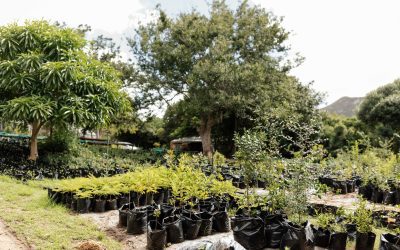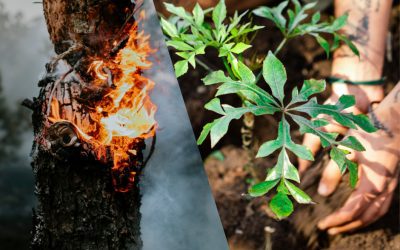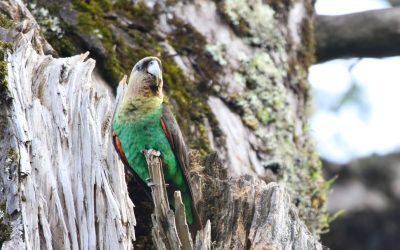Trees Greenpop Plants
26
MARCH, 2021
By Charlotte Mostert
6 Trees that Greenpop Plants which make a difference to our reality. Trees are vital to all of our survival, for they generate oxygen and medicine; store carbon; prevent enormous loss of soil; and provide shelter to the wildlife.
The Knysna Forest, in the Western Cape, is the largest forest in Southern Africa, covering 60,500 hectares. Historically the Khoikhoi and San people use to live here. The San hunters would smoke animals out of the forest and once the Dutch settled here they used the Outeniqualand to farm, fish, and cut timber.
Ilex mitis
Ilex (Latin) = Holm oak, mitis (Latin) = Unarmed
Within the family of Aquifoliaceae, Ilex mitis is more commonly known as Cape holly (ENG); umDuma (XHOSA); Waterboom (AFR), iPhuphuma (ZULU); mutanzwa-khamelo (VENDA); Monamane (NORTHERN SOTHO); Phukgile (SOUTHERN SOTHO).
This whitish-grey evergreen tree can grow between 10 and 25 m tall and have white and sweetly scented small flowers before a bright red fruit begins to develop. Most commonly found growing on the banks of rivers and streams and moist spots in woods and forests.
Rubbing the leaves together creates a lather that use to be used as soap for woodcutters to wash in the streams. In Zulu the name Phuphuma means ‘it foams out’ and in Venda, the name translates to ‘milk-pail washer’.
The wood is currently still being used for handles and furniture as well as fuel. Previously the wood was used in ladies’ shoe heels, as well as the construction of wagons for buckboards and spokes.
Apodytes dimidiata
Apodytes (Greek) = ‘to strip off’ – referring to the uncovered petals of the flower.
Dimidiata = ‘two equal parts’ – referring to the fruit.
A protected tree in South Africa, within the family of Icacinaceae, Apodytes dimidiata is more commonly known as white pear (ENG); umdakane (XHOSA); witpeer (AFR); umdagane (ZULU); tshiphopha-madi (VENDA); kgalagangwê (NORTHERN SOTHO).
The pale grey and evergreen bushy tree can grow up to 4/ 5m tall but can reach a height of 20m when in a forest. They have small, white flowers which are pollination magnets before producing a black and flattened fruit in mid to late summer.
The hardwood is currently used for agricultural implements, fence posts, and furniture. In the Zulu tradition, the tree is valued for its medicinal properties. Traditionally the root bark would be infused and used as an enema for intestinal parasites, and the leaves for the treatment of ear inflammation.
Rapanea melanophloeos
Rapanea = Guinean name
Melanophloeos = ‘dark bark’
Within the family of Myrsinaceae, Rapanea melanophloeos is more commonly known as Cape Beech (ENG); isiQwane sehlati (XHOSA) = ‘Protea of the forest; Boekenhout (AFR); IsiCalabi (ZULU).
The grey tree can grow up to 4-18 m high, in damp areas of mountain and coastal forests or swamps and bush clumps. They have small, white/ creamy yellow flowers and producing purple fruit, it is not uncommon to find the flowers along with the fruit on the same tree.
The hardwood is currently used for violins and furniture. Nguni people use the tannin from the bark as a charm to protect themselves from evil spirits (iNtelezi). The roots and bark are also more widely used medicinally for respiratory problems and muscular/ heart complaints.
Olea europaea subsp. africana
Olea (Latin) = Olive
Europaea (Latin) = from Europe
Africana (Latin) = from Africa
Within the family of Oleaceae, Olea europaea is more commonly known as Wild Olive (ENG); Oienhout (AFR); Umnquma (XHOSA, ZULU, SWATI); Mutlhwari (VENDA); and Mohlware (NORTHERN SOTHO, SOUTHERN SOTHO).
The evergreen tree can grow up to 12m high when growing near water alternatively on rocky hillsides or woodland. They have white to greenish flowers before producing small, spherical, purple-black fruits.
The tree is very resourceful for drier climates because of its hardwood and it is frost; drought; and wind-resistant, making it the perfect fodder tree. The leaves are used to make tea, the juice of the fruit is used to make ink and the hardy wood is used to make furniture. The early Cape settlers treated diarrhea with fruits and traditional remedies were made to improve kidney function, lower blood pressure, and deal with sore throats.
Virgilia
Virgilia = The greatest of Roman poets “Virgil”.
The species name ‘oroboides’ = Oribus, the biology of plants that have pea flowers.
The V. oroboides is divided into two subspecies,
The V. oroboides subsp. ferruginea is the rose-violet-flowered plant whose leaves and twigs are covered in rust-colored hairs that occurs near George.
The V. oroboides subsp. Oroboides is the pale, pink-flowered plant whose leaves and twigs are covered with white hairs and occurs between Cape Peninsula and Swellendam.
Within the family of Fabaceae, Virgilia is more commonly known as Blossom tree (ENG); and Keurboom (AFR) – ‘the pick of all trees’.
This silver-grey tree can grow between 10 and 15 m tall with an average lifespan being 12 to 20 years. With green pinnately compound leaves, where the main difference is that the V. oroboides leaflets are covered in velvety hairs and the V. divaricata are hairless. The wood is currently still being used for rafters and furniture. Where the transparent gum is used as a starch substitute. Most commonly found growing on forest margins, next to streams or on river banks but also on hillsides and thickets.
Podocarpus latifolius (Thunb.) R.Br. ex Mirb.
Podo (Greek) = foot
Carpus (Greek) = fruit
Lati(Greek) = wide
Folius (Greek) = leaf
Within the family of Podocarpaceae, Podocarpus latifolius is more commonly known as Real yellowwood (ENG); umkhomba (XHOSA); Geelhout (AFR), umsonti (ZULU); muhovho-hovho (VENDA); mogobagoba (NORTHERN SOTHO).
This timber tree is a yellow colour that can grow between 20 and 30 m, with long and narrow green leaves. Most commonly found growing mountainous areas, forests, and rocky hillsides. The male trees cone between July and September, making use of wind pollination. Where the female trees grow round grey/blue seeds on their receptacles from December till February.
For many years the wood was used in a variety of furniture and floorboard making, as well as for coffins and butcher blocks. The railway once used wood for railway sleepers.
Trees are the longest living organism on this planet. Methuselah, a bristlecone pine (Pinus Longaeva), is the oldest living tree, it has been identified to be older than 5000 years old and is located in the White Mountains of California. Why not come make your mark by planting some majestic trees with Greenpop at our Eden Festival of Action that might be able to take the new spot of the longest living tree one day.
Resources:
https://en.wikipedia.org/wiki/Knysna%E2%80%93Amatole_montane_forests
http://pza.sanbi.org/ilex-mitis
http://pza.sanbi.org/apodytes-dimidiata-subspdimidiata
http://pza.sanbi.org/rapanea-melanophloeos
http://pza.sanbi.org/olea-europaea-subsp-africana
http://pza.sanbi.org/virgilia
http://pza.sanbi.org/podocarpus-latifolius
https://www.treehugger.com/the-worlds-oldest-living-trees-4869356
https://www.savatree.com/whytrees.html
https://www.numerology.com/articles/about-numerology/single-digit-number-6-meaning/
https://saforestryonline.co.za/articles/southern-cape-forests-survive-largely-unchanged-for-centuries/
Greenpop’s Innovative Restoration Methodology and the Uilenkraal Forest Restoration Project
Read more about Greenpop’s innovative restoration methodology and the Uilenkraal Forest Restoration Project.
.
From Fires to Flora: A Blueprint for Wildfire Resilience and Forest Restoration
Read more about the Garden Route Wildfires and how Greenpop helped restore the forest of Heartland, forging a more fire-ready ecosystem.
Beyond Trees: Restoring Biodiversity & Protecting the Endangered Cape Parrot
Beyond Trees: Restoring Biodiversity & Protecting the Endangered Cape Parrot11 SEPTEMBER, 2025Forests are vital to the health of our planet, but not all forests are created equal. As a report by the IUCN and Greenpop explains, "Primary forests store more carbon...
Greenpop Foundation NPC is a registered non-profit organisation. Registration Number (NPO): 151-411 NPO.



